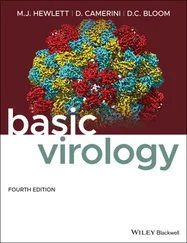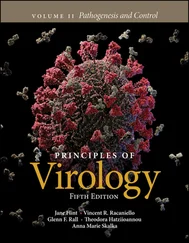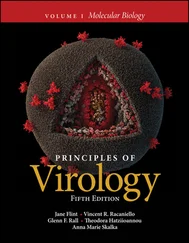Jane Flint - Principles of Virology
Здесь есть возможность читать онлайн «Jane Flint - Principles of Virology» — ознакомительный отрывок электронной книги совершенно бесплатно, а после прочтения отрывка купить полную версию. В некоторых случаях можно слушать аудио, скачать через торрент в формате fb2 и присутствует краткое содержание. Жанр: unrecognised, на английском языке. Описание произведения, (предисловие) а так же отзывы посетителей доступны на портале библиотеки ЛибКат.
- Название:Principles of Virology
- Автор:
- Жанр:
- Год:неизвестен
- ISBN:нет данных
- Рейтинг книги:3 / 5. Голосов: 1
-
Избранное:Добавить в избранное
- Отзывы:
-
Ваша оценка:
- 60
- 1
- 2
- 3
- 4
- 5
Principles of Virology: краткое содержание, описание и аннотация
Предлагаем к чтению аннотацию, описание, краткое содержание или предисловие (зависит от того, что написал сам автор книги «Principles of Virology»). Если вы не нашли необходимую информацию о книге — напишите в комментариях, мы постараемся отыскать её.
Volume I: Molecular Biology
Volume II: Pathogenesis and Control
Principles of Virology, Fifth Edition
Principles of Virology — читать онлайн ознакомительный отрывок
Ниже представлен текст книги, разбитый по страницам. Система сохранения места последней прочитанной страницы, позволяет с удобством читать онлайн бесплатно книгу «Principles of Virology», без необходимости каждый раз заново искать на чём Вы остановились. Поставьте закладку, и сможете в любой момент перейти на страницу, на которой закончили чтение.
Интервал:
Закладка:
Knipe DM, Howley PM (ed).2013. Fields Virology , 6th ed. Lippincott Williams & Wilkins, Philadelphia, PA.
Luria SE.1953. General Virology . John Wiley & Sons, Inc, New York, NY.
Murphy FA, Fauquet CM, Bishop DHL, Ghabrial SA, Jarvis AW, Rasmussen N.1997. Picture Control: the Electron Microscope and the Transformation of Biology in America 1940–1960 . Stanford University Press, Stanford, CA.
Oldstone MBA.2010. Viruses, Plagues, & History: Past, Present, and Future . Oxford University Press, New York, NY.
Papers of Special Interest
Boylston AW.2018. The myth of the milkmaid. N Engl J Med 378:414–415.
A delightful scientific historian’s report on research that debunks the much-cited notion that Edward Jenner was inspired to test the benefits of cowpox by the comments of a milkmaid who claimed to be immune to smallpox because she had had cowpox.
Breitbart M, Salamon P, Andresen B, Mahaffy JM, Segall AM, Mead D, Azam F, Rohwer F.2002. Genomic analysis of uncultured marine viral communities. Proc Natl Acad Sci U S A 99:14250–14255.
Early use of metagenomic analysis to identify viruses in natural marine environments. One of the first to identify these agents using these methods, and to reveal the enormity in number of previously unknown viruses in these environments.
Crick FHC, Watson JD.1956. Structure of small viruses. Nature 177:473– 475.
Authors deduce from X-ray crystal analysis of plant virus particles that virus shells (capsids) are composed of a large number of identical protein molecules, of small or moderate size, packed together in a regular manner.
Murray NE, Gann A.2007. What has phage lambda ever done for us? Curr Biol 17:R305–R312.
The authors describe how study of the bacteriophage lambda has contributed to an understanding of the molecular basis of numerous fundamental biological processes.
Suttle CA.2007. Marine viruses—major players in the global ecosystem.
Nat Rev Microbiol 5:801–812.
Suttle describes the unappreciated yet enormous contribution that the huge numbers of marine viruses make to the earth’s marine and global ecosystems.
Websites
https://talk.ictvonline.org/taxonomy/Latest update of virus classification from the ICTV.
http://ictvonline.org/ICTV-approved virus names and other information as well as links to virus databases can be downloaded.
http://microbe.tv/twivA weekly podcast about viruses featuring informal yet informative interviews with guest virologists who discuss their recent findings and other topics of general interest.
STUDY QUESTIONS
1 What is the definition of a virus?
2 Which is a key property first discovered about viruses that distinguished them from other microorganisms?They were too large to pass through a 0.2-micron filterThey could reproduce only in brothThey made tobacco plants sickThey were small enough to pass through a 0.2-micron filterNone of the above
3 All of us carry many different viruses throughout our daily lives. Why don’t they make us sick?
4 Why do we care that viruses comprise the most biodiversity on the planet?
5 The first viruses were discovered near the end of the 1800s. How was this done?By transmitting a disease to tobacco plants using a cell-free filtrate of diseased leavesPasteur showed that viruses could reproduce in a sterile mediumLeeuwenhoek saw viruses in his microscopeRobert Koch showed that viruses grown in broth could cause diseaseAll of the above
6 Why were the bacteriophage systems so useful for elucidating principles of viral reproduction? What important features of virus-host interactions were discovered from these studies?
7 How are viruses classified?
8 How does the discovery of new viruses today differ from 100 years ago?
9 Which host cell function is essential for the reproduction of all viruses?
10 What is the basis of the Baltimore classification system? How many genome types are sufficient to describe all viral families in this system?
2 The Infectious Cycle

Introduction
The Infectious Cycle The Cell Entering Cells Viral RNA Synthesis Viral Protein Synthesis Viral Genome Replication Assembly of Progeny Virus Particles
Viral Pathogenesis
Overcoming Host Defenses
Cultivation of VirusesCell Culture Embryonated Eggs Laboratory Animals
Assay of Viruses Measurement of Infectious Units Efficiency of Plating Measurement of Virus Particles
Viral Reproduction: the Burst Concept
The One-Step Growth Cycle One-Step Growth Analysis: a Valuable Tool for Studying Animal Viruses
Global Analysis DNA Microarrays Mass Spectrometry Protein-Protein Interactions
Single-Cell Virology
Perspectives
References
Study Questions
LINKS FOR CHAPTER 2
Video: Interview with Dr. Thomas Hope http://bit.ly/Virology_Hope
Cloning HeLa cells with Philip I. Marcus http://bit.ly/Virology_Twiv197
Ode to a plaque http://bit.ly/Virology_Twiv68
Movie 2.1: Plaque formation by vesicular stomatitis virus http://bit.ly/Virology_VZVGFP
Think globally, act locally http://bit.ly/Virology_Twim90
You know my methods, Watson.
SIR ARTHUR CONAN DOYLE
Introduction
Viruses are unique: often made up of nothing more than a nucleic acid molecule wrapped in protein, they parasitize the cellular machinery to produce thousands of progeny. This simplicity is misleading: viruses can infect all known life forms, and they comprise a variety of structures and genomes. Despite such variety, viruses are amenable to study because all viral propagation can be described in the context of three fundamental properties, as noted in Chapter 1: viral genomes are packaged inside particles that mediate their transmission from cell to cell; the viral genome contains the information for initiating and completing an infectious cycle; viruses establish themselves in a host population to ensure virus survival.
How viruses enter individual cells, their genomes are replicated, and new infectious particles are assembled are some of the topics of research in virology. These studies are usually carried out with cell cultures because they are a much simpler and more homogeneous experimental system than animals. Cells can be infected in such a way as to ensure that a single reproduction cycle occurs synchronously in every infected cell, called one-step growth. A full understanding of viral infectious cycles also requires knowledge of cell biology. Consequently, to reproduce the diversity of cells and architectures that are typical of tissues and organs, three-dimensional culture systems have been developed. In this chapter we begin with a brief overview of the infectious cycle, followed by a discussion of methods for cultivating and assaying viruses and detecting viral proteins and genomes and a consideration of viral reproduction and one-step growth analysis.
The Infectious Cycle
The production of new infectious particles can take place only within a cell ( Fig. 2.1). Virologists divide viral infectious cycles into discrete steps to facilitate their study, although in virus-infected cells no such artificial boundaries occur. The infectious cycle comprises attachment and entry of the particle, production of viral mRNA and its translation by host ribosomes, genome replication, and assembly and release of progeny particles containing the genome. New virus particles produced during the infectious cycle may then infect other cells. The term virus reproductionis another name for the sum total of all events that occur during the infectious cycle.
Читать дальшеИнтервал:
Закладка:
Похожие книги на «Principles of Virology»
Представляем Вашему вниманию похожие книги на «Principles of Virology» списком для выбора. Мы отобрали схожую по названию и смыслу литературу в надежде предоставить читателям больше вариантов отыскать новые, интересные, ещё непрочитанные произведения.
Обсуждение, отзывы о книге «Principles of Virology» и просто собственные мнения читателей. Оставьте ваши комментарии, напишите, что Вы думаете о произведении, его смысле или главных героях. Укажите что конкретно понравилось, а что нет, и почему Вы так считаете.











